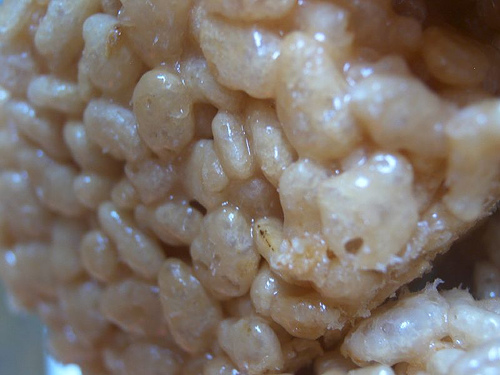Water is the enemy of pavement. It gets into cracks, freezes, expands, and makes bigger cracks. It makes the ground beneath roads soggy and soft. Drive some heavy trucks over those roads and they can give way, forming potholes and ruts. Even when it’s not destroying the road, water pools on the surface, turning cars into dangerous hydroplanes and splashing buckets of filthy water onto windshields and pedestrians.
Water is the enemy of pavement—unless that pavement is permeable.
Permeable pavement is pocked with pores that allow the water to trickle through it like a rock-based rice crispy treat. In freezing temperatures the water has room to expand inside the pores without cracking the material. Potholes are less of a problem because the pavement is laid on top of a bed of gravel, which allows water to drain through to the absorbent soil below while maintaining a firm foundation under the road surface. There’s no standing water puddling on top of the road causing sliding and splashing.
And permeable pavement helps solve the top two problems created by polluted runoff: dirty stormwater that poisons streams and lakes, and the tsunamis of water that gush through creeks and flood buildings. Permeable pavement cleans the water as it trickles through it into the soil, and it helps the dirt soak up the water, recharging pockets of buried groundwater.
But just how does a simple roadway shrink our stormwater woes and make streets safer to drive, bike, and walk on? Here’s how.
Just like conventional pavement, permeable pavement comes two ways: asphalt or concrete. But don’t confuse or refer to the two interchangeably: the rivalry between porous asphalt and pervious concrete is akin to the Yankees vs. the Red Sox.

Both asphalt and concrete are made from crushed-up rocks, or aggregate, but their “binder”—the marshmallows, if you will, in the rice crispy treat — sets them apart. The batter that makes asphalt roads stick together is the asphalt or bitumen, which is a sticky, viscous petroleum product. The glue used for concrete roads is a paste of cement and water.
Both asphalt and concrete pavements are made permeable by removing the sand and small particles, called “fines,” from the crushed rock, and by using rocks of uniform size.
Imagine a jar filled with uniform marbles compared with one filled by a mixture of big and small marbles. In the latter, the little marbles can squeeze into the gaps made by the big marbles, packing them more densely. By using same-size rocks, permeable pavement preserves the air gaps and allows water to filter through. It’s a departure from conventional pavement where the air is squeezed out, creating a solid impervious pavement.
But the rock mix isn’t the only thing that sets permeable pavement apart from its denser cousins. To understand how permeable pavement works, we need to start on the ground and work our way up.

Native soils or subgrade:
First thing first is figuring out what kind of dirt you are working with. Is it sandy, silty, clay, or rocky? Will it get mushy when it’s soaking wet? And how fast does water move through it? Experts disagree about how absorbent the soil needs to be for permeable pavement to work well. There’s also debate about whether porous roads will work on sloped sites and in areas where the groundwater flows a short ways beneath the surface.
Folks do agree that it’s important not to compress and compact the soil with heavy equipment, or you’ll lose some of the absorbency.
Geotextile fabric:
Once the soil is gently prepped, many projects call for the installation of porous, geotextile fabric. The sturdy fabric can provide some structural support beneath the road, and possibly filter out some pollutants. Again, there’s debate on this matter. Opponents to the fabric argue that it can capture fine particles, get clogged, and block the water from soaking into the soil.

Base or reservoir:
This is the layer of rock that rests on top of the soil (and possibly on geotextile fabric). It helps the water drain away from the pavement and can store some of the water until it soaks into the soil (hence the name “reservoir”). It also provides structure and support for the pavement, particularly if the underlying soil is prone to getting mushy when wet, like clay can.
As with the rocks or aggregate used in the asphalt/concrete layer, the rocks in this base also need to be of a more uniform size with the dirt and small particulars removed. Getting clean, uniform rocks can be done most cheaply by sifting it through a screen or sieve, and some experts call for the more expensive step of washing the rocks. The reservoir layer is generally 40 percent air space, or “voids” among the rocks.
Choker:
This is another, thinner layer of rock that provides a foundation for pavement. Some say it’s necessary, others say it’s not.
Porous asphalt or pervious concrete:
The top layer of the pavement is asphalt or concrete, again with uniform-size rocks to create air pockets. However, there’s a range of rock sizes that can be used, which will help determine how much air space or voids are created, and how pervious the pavement will be.
Porous asphalt can be 16-20 percent voids, while pervious concrete can range from 14-31 percent voids. Sometimes fibers are added to make the pavement stronger, and you can also adjust the amount and type of binder to adjust the performance of the pavement.
The rest of the story
In very broad strokes, those are the basic components of a permeable road, sidewalk, or parking lot, with only a hint at the caveats, debates, and variables that go into building these structures. But all of those caveats, debates, and variables are important. It means each project requires careful, site-specific engineering by people who understand this technology. The uncertainty also means that there’s a tendency to overbuild a project with deeper rock reservoirs to ensure a road is strong enough and drains well, but that overbuilding quickly adds to the cost. And it means that folks are anxious to try permeable pavement because it’s less of a cookie-cutter project.
But there are great projects all around the Northwest that can be used as models, and the amount of research demonstrating best practices and the benefits of permeable pavement is growing.
Even still, there are big ranges in how people are installing these pavements and what the experts advise. Let’s look at an asphalt road, just to get a sense of the variability we’re talking about. The depth of the asphalt layer, when used on a road:
- 4.5 inches — Pringle Creek, Oregon
- 7 inches — Rainier Boulevard, Issaquah
- 8 inches — N. Gay Street, Portland
Then the base or reservoir can have a huge range of depths, again considering just asphalt projects:
- 6 inches — N. Gay Street, Portland
- 6-12 inches — Dave Bell, quality control manager at Lakeside Industries in Issaquah
- 10 inches — Rainier Boulevard, Issaquah
- 12-36 inches — Oregon Sea Grant Extension
- 18 inches — Pringle Creek, Oregon
- 18-36 inches — Tom Cahill; Washington Department of Transportation
There seems to be less variability when it comes to pervious concrete. Generally for a roadway the concrete will be about 4-8 inches deep and the rock base layer beneath it will be 6 inches (see figure D4). However, concrete is more expensive.
None of this is insurmountable, and again, science and experience are helping to refine these numbers. But it does give one a renewed appreciation for all of the infrastructure out there, both the permeable, green variety and the conventional pavement. This stuff can be tricky, and a lot of money and public safety are at stake.
As Andy Marks, managing director of the Concrete Council, explained to me, you don’t want people noticing their roads and highways, because if they do, it likely means there’s something wrong with it.
“If we do things right as civil engineers,” Marks said, “people don’t think about it.”
There are some great resources that provide more detail in how to build permeable roads, and that highlight local projects, good and bad. Some of my favorite Permeable Pavement 101 resources:
- Permeable pavement literature review in Appendix D of the Washington State Department of Transportation State Materials Laboratory’s “WSDOT Strategies Regarding Preservation of the State Road Network: A Report to the State Legislature in Response to SB 6381,” September 1, 2010.
- PowerPoint presentation from Kathryn Gwilym at SvR Design Co. titled “Permeable Paving: Examples and Lessons Learned,” from October 17, 2007.
- PowerPoint presentation from Mark Palmer with the city of Puyallup titled “Design and Construction of Porous Asphalt Pavements,” from May 17, 2011.
- Thomas Cahill, Michele Adams, and Courtney Marm, “Stormwater Management with Porous Pavements,”Government Engineering, March-April 2005.
- A Q&A with Bruce K. Ferguson on permeable pavement that ran in the American Society of Landscape Architects’ Water Conservation Newsletter, Winter 2010.
- Vernon R. Schaefer, John T. Kevern, and Kejin Wang, “An Integrated Study of Pervious Concrete Mixture Design for Wearing Course Applications,” Iowa State University’s Institute for Transportation, October 2011.
- Maria Cahill, Derek C. Godwin, and Marissa Sowles, “Porous Pavement,” Oregon Sea Grant Extension, 2011.


Comments are closed.